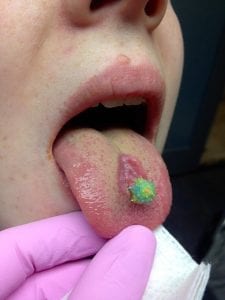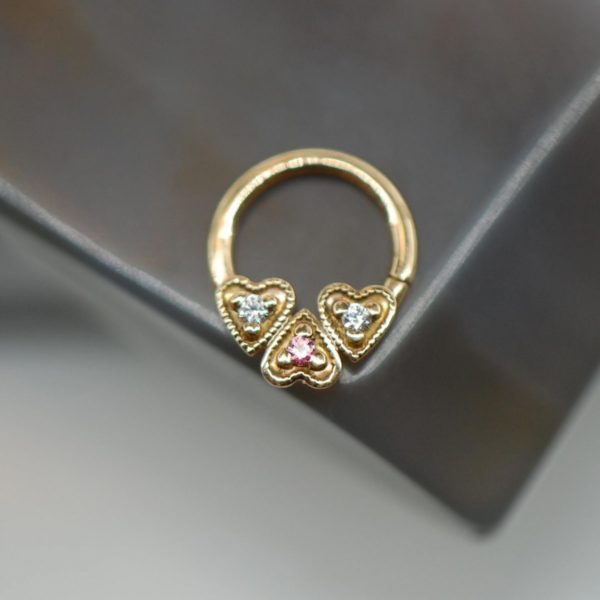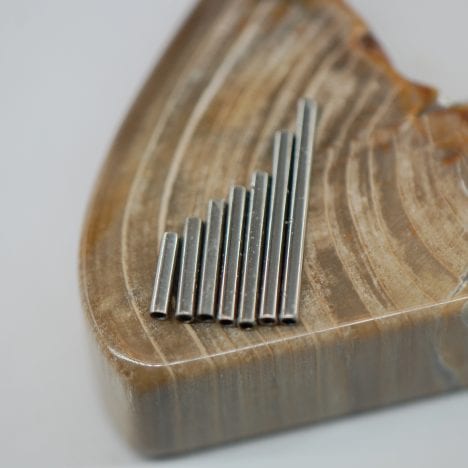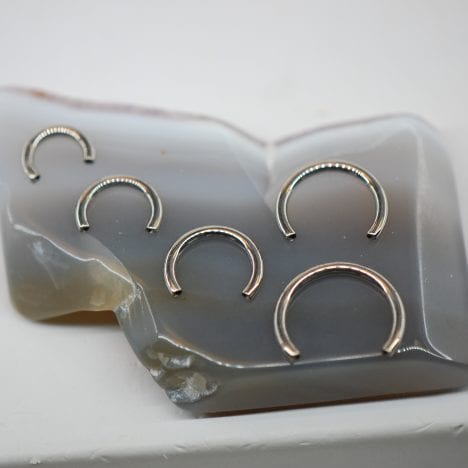There’s a wide range of materials out there that people use for body jewelry. From metals, woods, horns, and stones there’s no shortage of material to wear. And most materials, like anything else, have a good version, and a not so good version. Acrylic is one of the few materials that, across the board, does NOT come in any safe variety. That’s right folks, there is NO safe acrylic or plastic* body jewelry. Let’s examine a little closer.
What do we mean when we say Acrylic?
If you look online many manufactures sell acrylic body jewelry. Across the board however they only list “acrylic” for the material. But what does this actually mean? There are thousands of types and varieties of plastic polymer that fall under the umbrella term “acrylic”. Acrylate Polymers belong to a family of polymers commonly known as “Acrylic.” Different mixtures and bonds of these polymers make up different mixtures and varieties of acrylic. PMMA is the most commonly used synthetic polymer advertised as “acrylic” for body jewelry and other purposes. PMMA stands for poly methyl methacrylic. It’s used as an alternative to glass, for casting resins, for ink and paints, for nails and polish, and hundreds of other uses. Pure PMMA has uses in medical implants and bone glues for it’s biocompatibility . Pure PMMA however is quite expensive, so most companies work with composites and other mixtures that change the structure of PMMA and make it easier and more affordable to work with. These composites can have any range of additives, fillers, and other random chemicals mixed in, and there is limited regulation in many countries about what fillers end up used. Dyes, pigments, other plastics, liquid chemicals, and other acrylate polymers are all things that have been discovered as filler in various forms of PMMA. Many of these fillers and monomers are known carcinogens- meaning they are known to cause cancer.
But there is implant grade PMMA?
Yes, there is biocompatible implant grade PMMA. This PMMA is rigorously tested for its hardness, tensile strength, compression strength, molecular weight, and monomer content. For biocompatibily it is tested with cytocompatiable, mutagenicits, sensetization, undergoes toxicological risk assessments, and, yes, is tested on animals. Beyond that, most lots of implant grade materials including PMMA must be traceable- everyone who handles, or comes in contact with these materials signs off to ensure they have been properly handled.
So how do I buy this implant grade Acrylic?
Well- you don’t. Body Jewelry companies aren’t working with implant grade PMMA. It’s too expensive, too inaccessible , and too unique to work to be cost effective for them. These tests aren’t performed on commercial and mass produced PMMA- they are just too costly. Thus- no commercially accessible Acrylic is going to be implant graded. Because of this mass market PMMA isn’t going to have the same amazing properties (biocompatiably as proved by through testing, and proper hardness, tensile strength, and other qualities) as implant grade PMMA.
If I’m not buying that, what AM I buying?
Well, its impossible to say for sure because most companies won’t release their specific formulas. It’s safe to assume that it is some form of PMMA. But how safe is it really? Well, many forms of acrylic have been found to be human carcinogens. A Canadian study published in 2010 found that women who work around and with common synthetic materials could be tripling their risk of breast cancer after menopause. The study covered women working with textiles, particularly those with acrylic fabrics and fibers and nylon fibers. The important take away of this study is that chemical they attributed to this- acrylonitrile enters our bodies through skin absorption according to the CDC. These women had higher risks from working around fabrics and producing fabrics that contained these chemicals- imagine wearing them in your ears or mouth or nose for extended periods of time! According to the CDC some of the main targeted organs by these chemicals included the skin- exactly what acrylic body jewelry is in contact with most of the time!

What about Bioplast?
Bioplast/bioflex are names used for plastic body jewelry. These companies assert their materials are implant grade and biocompatible – however they have not released the Material Data Sheets telling people exactly what they are made of. They have no studies verifying they have been put through the same rigorous study and testing as implant grade PMMA. A quick search will show no evidence of FDA or CDC approval of the material either. Unfortunately , there are not great laws about body jewelry advertising or internet advertising . Many companies can claim their jewelry or materials are “safe” “biocompatible ” or “better for healing” without any actual medical or scientific evidence to back these claims. Until these companies can offer irrefutable evidence their materials are safe, it’s simply not worth the risk to potentially wear a known carcinogen.
But I heard Acrylic and Plastic is better for oral piercings to stop you from chipping your teeth?
Anything harder then your teeth can chip or damage them- kids hurt their teeth on plastic toys, acrylic brace components, and just eating food the wrong way! The risk of acrylic jewelry breaking down over time and absorbing chemicals makes it not worth wearing. Properly fitted, implant grade titanium jewelry will prevent chipping, as well as being diligent with not playing with or chewing on your jewelry.
I have an MRI/medical procedure, and I can’t wear metal. What can I do?
There are a few different choices. First- implant grade titanium is actually MRI and X-ray safe- you can wear that jewelry for most medical imaging! If for a procedure you MUST remove your metal jewelry, there are quartz glass and medical grade silicone retainers from companies like Glasswear Studios, Gorilla Glass, and Kaos Softwear which are safe, non metallic, and perfect for most procedures.
In short, don’t be fooled by tag lines can catchy claims. Acrylic body jewelry is too-good-to-be-true cheap for a reason- it’s not made with safe materials and not intended to be worn in your body for any extended period of time. Ditch the plastic, and invest in some high quality implant grade metals, glass, stone, or other organics, which are safe for long term and short term wear!
Occupational and Environmental Medicine 2010, 67:263-269 doi: 10.1136/oem.2009.049817 https://www.cdc.gov/niosh/npg/npgd0014.html *- there are some makers working with safe PTFE and Delrin for large gauge jewelry (plugs, pieces for stretched piercings) but that is the extent of safe plastic presently in the industry. As far as most standard size piercings, no one is working with safe polymers.






